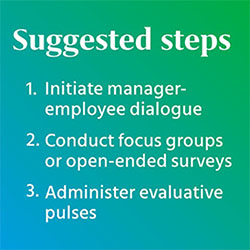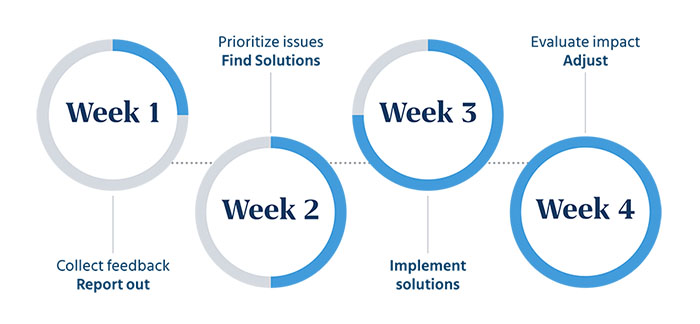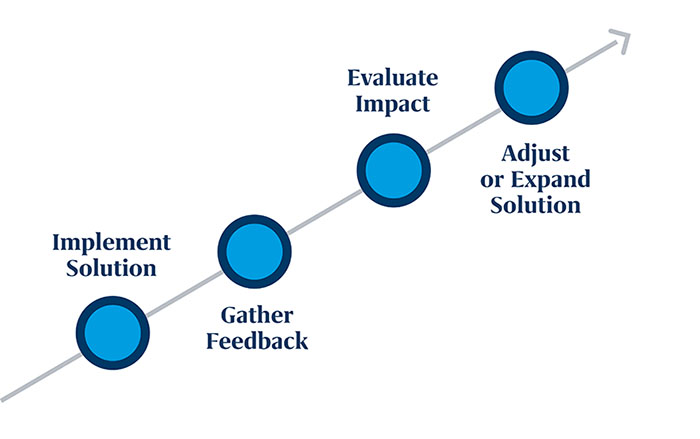Employees are back in the office — how’s it going?
In recent months, we’ve seen many organizations announce that they are requiring employees to return to the office. Many indicated that collaboration and innovation were suffering and the development of newly hired employees was impacted without face-to-face interaction. While still recognizing the importance of providing flexibility, most employers are telling employees that they need to be in the office more consistently or on set days. Many are still offering hybrid work, though, by allowing employees to continue working outside of the office on some days.
How do employees feel about this? According to Mercer’s Inside Employee’s Minds Survey with data collected late in 2022, there is a mismatch between what employees and employers want in terms of flexibility. At that time, employers were providing flexible working arrangements that amounted to an average of 3.5 days in the office. When employees were asked what they preferred, their ideal in office time was 2 days less, at 1.5 days in the office.
But, as you know, external market data is only a part of the story. What is it that your employees want in terms of in-office time? There’s only one way to find out how your employees are feeling — ask them!
The importance of employee listening
Right now, it’s more important than ever to find out how your employees are feeling, what they need to excel, and how you can help provide that for them. Even before the global pandemic, employees had ranked empathy as a key characteristic they were seeking in their employers, as revealed in the 2019 Mercer Global Talent Trends report. While employees are prioritizing balance and sustainability at the top, many still rank empathy toward workers and their needs as something that defines the future of work.
In today’s labor market, connecting with employees in meaningful ways should be a top priority. That’s really the only way you’ll be able to align the actions you can take, offerings you can provide, and programs you can implement with the needs of your unique employee population.
After all, your employees are key to keeping your organization afloat, so it’s important they feel confident that leadership is invested in their well-being. Two-way communication is how you instill that confidence in employees.
Let’s take a look at some suggestions for facilitating the conversation.
Craft an efficient and effective listening plan
It’s a good idea to connect with your employees in a variety of ways, typically beginning with the most direct connection: your employees’ managers.
The conversation should span beyond the expected work-related talking points — the manager can demonstrate empathy by asking a variety of questions that touch on all aspects of employees’ lives.
Starting with general questions such as, “How are you doing?” is a good way to establish a natural flow to the conversation.
|
 |
From there, the manager can get into more specific questions that help to facilitate a meaningful two-way exchange.
These could include:
- “How is your family?”
- “What can I do to support you at work?”
- “What are you doing to take care of yourself and relieve stress?”
By asking these types of questions, the manager is able to find out how your organization can support the employee, as well as identify any possible challenges or risk factors.
At the same time, engaging this way allows the manager to demonstrate empathy and forge a stronger relationship with the employee.
Another consideration is whether, or when, your organization should administer more formal listening approaches. Your budget, perceived level of disruption, and the return-to-office phase in which your organization is operating will all help you decide which steps to take and in which order. There are a few options to consider.
Pulse surveys tend to be short, easy to complete, and focused on one specific topic. They allow employers to quickly and frequently engage employees on a variety of topics, therefore enhancing communication, and they can be deployed easily. Mercer even has several ready-made options that include topics like remote work, senior leader effectiveness, employee wellness, and confidence in the future.
To efficiently capture both fully remote and hybrid employees, digital focus group tools can be excellent resources for virtually facilitating dynamic discussions among groups of employees to gain insight on a variety of topics in real time.
A major key to ensuring success, no matter how you choose to listen, is making sure the questions will lead to meaningful insight and actionable outcomes.
Gaining employee insights is, of course, incredibly valuable to your organization, but the process doesn’t end once you’ve asked the questions. You’ll see the real benefits after you share the results with employees and after management has developed its results-driven action plan.
Respond expediently
To reinforce just how important employee feedback is to your organization and to show that you value employees’ time, it’s key to deliver survey results and implement your action plan expediently.
To demonstrate the importance of the feedback provided by employees, consider fast-tracking your response planning and implementation process to gain trust and inspire confidence from your employees.
In a matter of weeks, you need to have collected feedback, identified priorities, implemented solutions, and evaluated the impact (maybe even by deploying follow-up pulse surveys or digital focus groups).

Depending on the situation your organization is facing, you may even choose to deploy a response even more aggressively by turning the actioning process on its head.
If there are clear issues that need to be addressed, perhaps you implement a solution first and then begin gathering feedback. This will allow you to demonstrate your willingness to act and then adjust the solution based on real-time feedback from employees.

However you do it, just engage
During times of change, silence from your organization is beyond deafening to your employees; your workforce needs to know that you care about their needs and are managing with confidence.
However you do it, you need to engage with employees — now more than ever.
Mercer is here to help as you navigate through these change and others as they come up. Whether you are fine tuning your retrurn to office strategy or ready to select from a variety of ready-to-go employee lisenting tools we've got you covered. Our tools will help you efficiently and effectively design a listening plan to meet your needs, address the topics of most concern, and provide your organization with actionable results — all within your budget, so you can deliver a better employee experience.
When you’re ready, we’re here to help. Contact us at surveys@mercer.com or 855-286-5302.